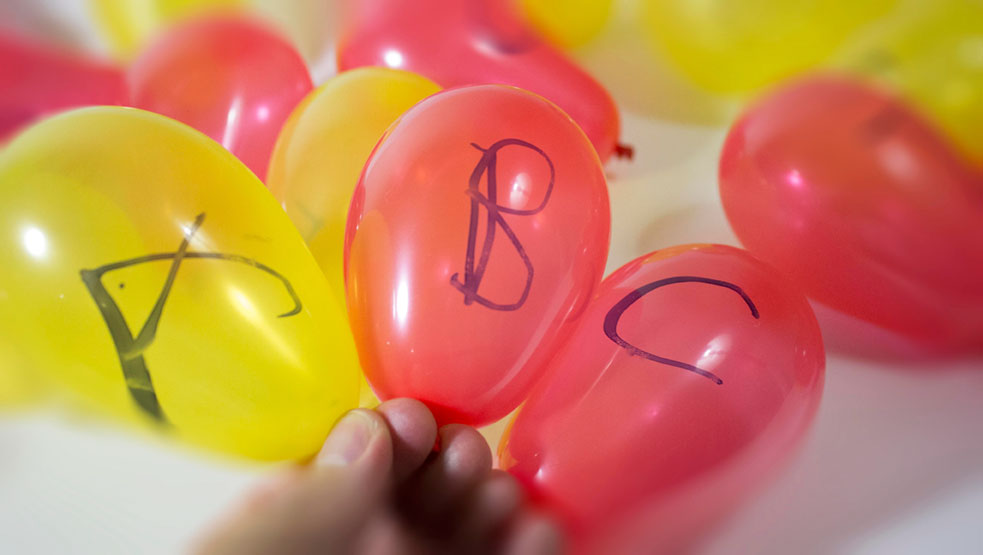Text is the very stuff of teaching. It is right there at the core of what we do. Written text is something we can move onto a wide range of surfaces and objects to increase entertainment and engagement for our young learner – and even teenage – students. I refer to this as text shift. Here, I would like to show you some examples.
By Chris Roland*
Balloons
Writing on balloons is a squeaky undertaking! It has a sense of impermanence, but it makes the writer alert. If the words that go on the balloons are copied from the board or are the students’ responses to exercises in a coursebook, what is – on the surface – a ‘wacky’ activity will still help you cover your language syllabus.
Eggs
Writing on blown-out eggs presents the students with a different but similar puzzle, which will increase mindfulness and encourage them to take care. Hollow eggs are fragile and need to be held gently. They also roll about, so they need holding onto well. Supporting language can be put on the board for the writing itself, whatever the theme, as can transactional language to enable the students to ask for the egg and a permanent marker pen in the first place.
Bricks
A brick, on the other hand, is very different from an egg or a balloon. It is flat and cold. The bumpy texture does not help, even after students have applied a coat of whitewash. Again, though, the finished product represents invested attention. Part of the challenge with the bricks, especially for younger writers, is managing to fit their text into the space available. To help, their drafts can be written on brick-sized templates.
Chris will be a plenary speaker at the 13th Foreign Languages Forum taking place on 25-26 August, at the Royal Olympic Hotel, Athens, GR
Stones
Activities like these contain an element of what I refer to as ‘soft’ rule breaking because they run contrary to the norms forged by daily routine in the collective imagination of us teachers and our students. I have been lucky enough to have had the chance to share these and other activities in a series of teacher training sessions entitled ‘Teacher who breaks the rules’ in Spain and Portugal.
One teacher attending, Ana Paula Freitas at the Academia de Lνnguas da Madeira, came up with her own blend of text shift. Her students collected pebbles from the beaches in and around Funchal and used correction fluid to cover them with their favourite maxims and mottos which they found online.
Chalk
One discovery that I made while working with traditional blackboards is that you can actually write on chalk with a soft pencil. So I prepared a whole box of chalk sticks, each one with six questions written on it.
Tablets
The Romans used wax tablets as portable, reusable notepads. They etched letters into the wax using a stylus. We can do the same with plastic plates and plasticine, with the teacher dictating words or even situations that involve a pictorial demonstration of student understanding. Students can also prepare their own plates/tablets.
How good their smearing and smoothing skills are will determine exactly how much plasticine is needed. A plastic plate dictation gives the students’ boardwork more of a 3D feel. If the topic is food, it fits thematically too – almost as if they are preparing these meals. The plates can be cleaned and reused.
Foil
Writing on foil-covered sheets of A4 paper can make rewrites of exam compositions just a little less painful.
Each other
Writing on each other takes things a step further. One class of teens each put on a rubber glove and wrote on a partner’s hand about their partner’s Christmas. There was a handout with question prompts for a mini-interview beforehand where they found out the information they needed, so the writing was the product of real communication.
Amidst all this novelty, if a student comes to me and says that they do not want to write on a brick, that is fine. I am not going to put myself in the ridiculous position of forcing a child to write on a balloon, brick or anything else. However, the language task is always serious, even if the imported surface is fun, so I do ask them to do the writing on paper, at least. This get-out option is often enough for the students to decide that the task, as originally proposed, might not be so bad after all.
Why bother? Your classes can be perfectly complete without needing to write on plastic, stone, foil or eggs. But it can be fun and, if presented as part of a structured task where the emphasis is still on language content, the opportunity to experience textures and manipulate objects beyond the notebook page can help bring writing to life.
*About Chris Roland
 Chris is based in Seville at ELI language academy. He has also taught and trained in Cádiz, Barcelona, Nottingham, Damascus and Aleppo. He has experience as both an IELTS and Cambridge examiner and has worked with teachers across a range of scenarios including school inspections and as a tutor on the Trinity Certificate and Diploma courses in methodology. He is a regular speaker on the conference circuit in Spain and Portugal and his particular interests lie in the area of exploiting written text, improving classroom management with teens and looking at the finer points of task design. His first methodology book Understanding Teenagers in the ELT Classroom will be available from Pavilion Publishers in September.
Chris is based in Seville at ELI language academy. He has also taught and trained in Cádiz, Barcelona, Nottingham, Damascus and Aleppo. He has experience as both an IELTS and Cambridge examiner and has worked with teachers across a range of scenarios including school inspections and as a tutor on the Trinity Certificate and Diploma courses in methodology. He is a regular speaker on the conference circuit in Spain and Portugal and his particular interests lie in the area of exploiting written text, improving classroom management with teens and looking at the finer points of task design. His first methodology book Understanding Teenagers in the ELT Classroom will be available from Pavilion Publishers in September.
